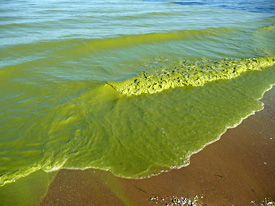The largest harmful algae bloom in Lake Erie’s recorded history likely was caused by the confluence of changing farming practices and weather conditions that are expected to become more common in the future due to climate change.
Rather than an isolated, one-time occurrence, Lake Erie’s monumental 2011 algae bloom was more likely a harbinger of things to come, according to U-M researchers and colleagues from eight other institutions.


A satellite image of Lake Erie on Sept. 3, 2011, overlaid on a map of the lake and its tributaries. This image shows the bloom about six weeks after its initiation in the lake’s western basin. Image courtesy Michigan Sea Grant . Below: A section of the Lake Erie algae bloom in September 2009, photographed on the southeast shore of Pelee Island, Ontario. Photo by Tom Archer.
The interdisciplinary team explored factors that may have contributed to the event and analyzed the likelihood of future massive blooms in the lake.
“Intense spring rainstorms were a major contributing factor, and such storms are part of a long-term trend for this region that is projected to get worse in the future due to climate change,” said aquatic ecologist Donald Scavia, director of the Graham Sustainability Institute, and professor of natural resources and environment, and civil and environmental engineering. “On top of that we have agricultural practices that provide the key nutrients that fuel large-scale blooms.”
A paper summarizing the team’s findings was published online April 1 in the journal Proceedings of the National Academy of Sciences.
The first author of the paper is former U-M researcher Anna Michalak, now at the Carnegie Institution for Science. Eighteen U-M co-authors from various departments and schools contributed to the study, which looked at land use, agricultural practices, precipitation, temperature, wind, lake circulation and surface runoff.
“This event was caused by a complex combination of factors, and I think this paper really puts all the pieces together in a very clear and systematic way,” said one of the co-authors, Allison Steiner, associate professor of atmospheric, oceanic and space sciences, and earth and environmental sciences.
The researchers found that a series of intense spring rainstorms and runoff events resulted in record-breaking levels of phosphorus, a nutrient in crop fertilizers that also fuels rampant algae growth, washing into western Lake Erie.
That set the stage for an algae bloom that covered about 2,000 square miles by the time it peaked in early October 2011. That’s more than three times larger than any previously observed Lake Erie algae bloom.
In their study, the researchers used 12 computerized climate models to determine if rainstorms like the May 2011 events are more likely to occur in the future. The models, which incorporate the anticipated effects of human-caused climate change due to the buildup of heat-trapping greenhouse gases, showed that the frequency of spring rainstorms that drop more than 1.2 inches is likely to double in this region by the end of the century.
Once the 2011 Lake Erie bloom formed, unusually warm water temperatures and calm winds created ideal conditions to promote summer algae growth. “All of these factors are consistent with expected future conditions,” the 29 authors of the PNAS paper wrote.
An algae bloom is a rapid buildup of algae in a body of water, and harmful blooms are those that damage other organisms — including humans — through the production of toxins or by other means. Algae blooms can foul harbors, clog boat motors, reduce fish populations and sometimes lead to the formation of low-oxygen “dead zones” where most aquatic organisms cannot survive.
In addition to meteorological conditions, other factors contributed to the 2011 Lake Erie algae bloom. Chief among them is the widespread adoption, since the mid-1990s, of no-till farming and other agricultural practices that have increased the availability of a type of phosphorous, known as dissolved reactive phosphorous or DRP, that promotes algae growth.
In addition to Michalak, Steiner, Moore and Scavia, authors of the PNAS paper are Eric Anderson, Dmitry Beletsky, Steven Boland, Nathan Bosch, Thomas Bridgeman, Justin Chaffin, Kyunghwa Cho, Rem Confesor, Irem Daloglu, Joseph DePinto, Mary Anne Evans, Gary Fahnenstiel, Lingli He, Jeff Ho, Liza Jenkins, Thomas Johengen, Kevin Kuo, Elizabeth LaPorte, Xiaojian Liu, Michael McWilliams, Derek Posselt, R. Peter Richards, Ed Verhamme, David Wright and Melissa Zagorski.

